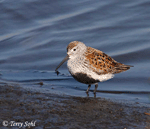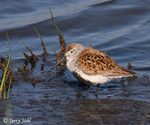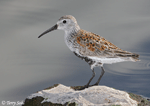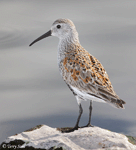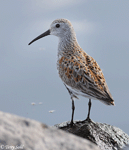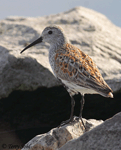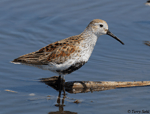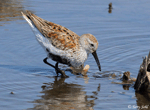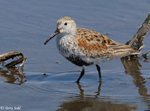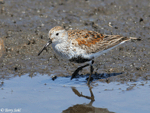| Length: 8 inches | Wingspan: 15 inches | Seasonality: Migrant |
| ID Keys: Black belly patch on spring adults. Also heavy droopy black bill. Similar to many other small sandpipers in winter plumage. | ||
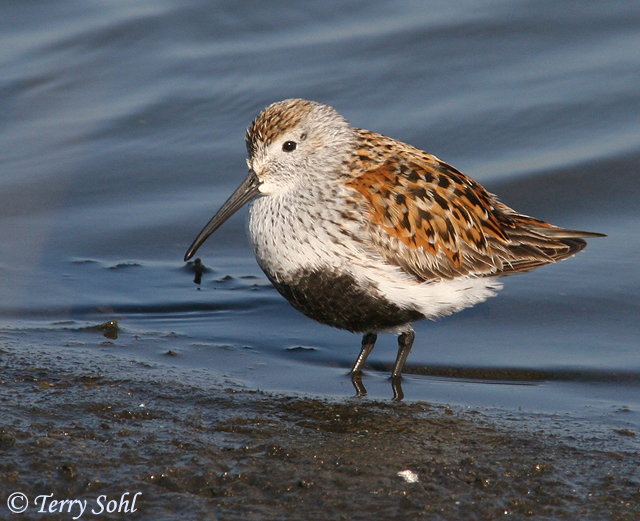 Vast differences are obvious in winter and breeding plumages,
as the Dunlin sports a ruddy brown back, white underparts, and black belly patch
in the spring, but has a very nondescript grayish plumage in the winter.
Dunlins generally tolerate colder weather better than many other shorebirds,
migrating southward relatively late in the fall and often overwintering as far
north as New England or the coast of Alaska. In South Dakota, they are
relatively common migrants in the spring, but are rare in the fall, primarily
because Dunlins move to the coastlines of North America for the winter.
Vast differences are obvious in winter and breeding plumages,
as the Dunlin sports a ruddy brown back, white underparts, and black belly patch
in the spring, but has a very nondescript grayish plumage in the winter.
Dunlins generally tolerate colder weather better than many other shorebirds,
migrating southward relatively late in the fall and often overwintering as far
north as New England or the coast of Alaska. In South Dakota, they are
relatively common migrants in the spring, but are rare in the fall, primarily
because Dunlins move to the coastlines of North America for the winter.
Habitat:
Flooded fields, lake margins, mudflats during migration. Breeds on mixed tundra/wetland in Canada and Alaska. Found in coastal habitats in the winter and in migration.
Diet:
Primarily insects and insect larvae on migration through the state. Also small mollusks and crustaceans, small fish, and some plant material.
Behavior:
Forages by walking along mudflats or very shallow water, plucking food items from the surface or by rapid probing in the mud.
Breeding:
Non-breeder in South Dakota. In breeding range, the nest of a Dunlin is a scrape on the ground lined with grasses and leaves, usually placed in a hidden area such as next to a clump of grass or small hummock. The female lays between 2 and 4 eggs, and both parents help to incubate them. When the eggs hatch, the young quickly leave the nest and find their own food, with the parents helping to protect them. The female however usually leaves after a few days, leaving the male to tend to the young. The young fledge after about 3 weeks.
Song:
The "song" of a Dunlin is a raspy zheeep, generally repeated a number of times. They have similarly raspy calls given as contact calls or flight calls, but often with just a single note.
1Click here to hear the flight calls/song of a Dunlin, recorded in far eastern Russia.
2Click here to hear the alarm / flight calls of a Dunlin, recorded in Mississippi.
Migration:
Summers in northern Canada and Alaska. Winters along North American coastlines. They migrate both along coastlines and the interior, but are much more common as interior migrants during the spring (including in South Dakota).
Interactive eBird Map:
Click here to access an interactive eBird map of Dunlin sightings
Similar Species:
Breeding plumage Dunlin are distinctive, with the trademark black belly. However, in other plumages they could potentially be confused with the following (focusing on species potentially found in South Dakota) in non-breeding plumage. It's less of an issue in the fall, as Dunlin are not nearly as common fall migrants as spring migrants in the state. However, some shorebirds moving through in the spring (particularly early spring) have yet to acquire full breeding plumage.
- Sanderling - Sanderlings in non-breeding plumage share the same general structure and grayish plumage. However, Dunlins have a longer bill with the slight droop, are darker gray overall, and have some grayish coloring on the upper breast (generally white in a non-breeding Sanderling).
- Western Sandpiper - Not a common migrant in South Dakota, but similar in non-breeding plumage. However, Western Sandpipers are considerably smaller, and have a noticeably shorter and straighter bill.
- Semipalmated Sandpiper - A much more common migrant than Western Sandpiper, and similar to Dunlin in non-breeding plumage. But again, they are considerably smaller, and have a noticeably shorter and straighter bill.
- Baird's Sandpiper - Perhaps the most likely to be confused with a Dunlin if both are in non-breeding plumage. Baird's Sandpipers share a slightly drooping bill (but shorter and thinner than a Dunlin). Baird's Sandpipers are larger and generally have some buffy wash on the upper breast.
Conservation Status:
Numbers have seemingly declined since the 1970's. However, they are still found over a wide geographic area and overall numbers are not threatened. The IUCN lists the Dunlin as a species of "Least Concern".
Further Information:
1) USGS Patuxent Bird Identification InfoCenter, Dunlin
Photo Information:
May 20th, 2005 -- Wetland near Wentworth -- Terry L. Sohl
Additional Photos:
Click on the image chips or text links below for additional, higher-resolution Dunlin photos.
Audio File Credits:
1Jens Kirkeby, XC385669. Accessible at www.xeno-canto.org/385669
2Hal Mitchell, XC316123. Accessible at www.xeno-canto.org/316123
| Click on the map below for a higher-resolution view |
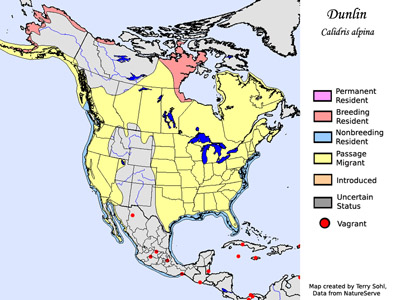 |
| South Dakota Status: Common spring migrant but rare fall migrant in the eastern part of the state. Accidental migrant in the western part of the state. |
Additional Dunlin Photos
Click for a higher-resolution version of these photos
